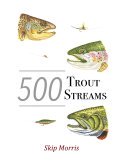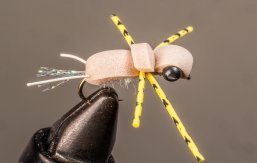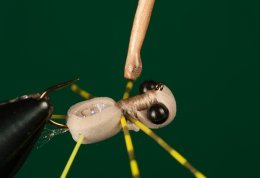Making the Matuka Wing
A Distinctive Feather Makes the Wing
The primary and most distinctive feature of the Matuka streamer is its wing—two or more long, soft feathers stripped to their quills on the underside,
bound along the top of a fly-body with tinsel or wire ribs.
The wing is called, predictably, a Matuka wing, and it's found its way onto a
variety of fly patterns over the years.
The History of the Matuka
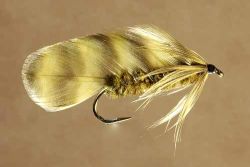 The Olive Matuka
The Olive Matuka
A fly-style from New Zealand, the Matuka was first revealed to North American fly fishers through Fly Fishing Strategy by Swisher and Richards, published in 1975.
That, at least, is what my research indicates.
Matukas were a hit, and soon began showing up in catalogs and fly boxes.
An Advantage Over Conventional Streamer Wings
This wing has two advantages over conventional streamer wings that are tied in only at the head of a fly:
- The Matuka wing stays connected with the body (the wing and body together suggest the profile of a small fish)
which the conventional streamer wing does not (leaving the impression of a small split fish), and
- the Matuka wing seldom fouls with the hook's bend, which the conventional streamer wing does fairly often.
Some might argue that the Matuka's bound wing is not so free to flex as the conventional streamer wing. Perhaps...but the Matuka sure catches a lot of fish.
Two feathers for the Matuka wing, or four, or even six?
Each number is effective, each has its supporters. Two to six—I don't think you can go wrong with any of them.
The Right Materials for Effective Matuka-Style Wings
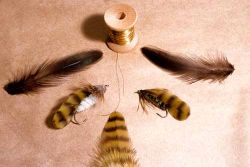 Feathers and rib material
Feathers and rib material
used to make a Matuka wing.
Wide, webby hackles make the best Matuka wings.
The widest and webbiest hackles I know of are hen-neck and Whiting's Chickabou (my favorite) hackles.
But tiers use everything from Rooster bass-hackles to the biggest softest hackles from a dry-fly neck for Matuka-style wings—all make a perfectly effective fly.
The standard rib for a Matuka is oval tinsel, gold or silver depending on the particular pattern.
But I prefer copper wire for three reasons:
- it's heavier than Mylar tinsel, so it adds a little extra weight to help get the fly down;
- it's finer than tinsel, so it tends to knock the hackle-fibers out of position less often; and
- ...well, I guess I just have a prejudice for copper wire.
A Variety of Popular Flies Use this Style of Wing
A lot of popular streamer patterns, such as the Muddler Minnow and various imitations of shad and smelt—just about any streamer with a hackle-wing can,
and probably has, become a Matuka.
And take a look at bass flies if you want to see some really interesting variations—Jimmy Nix's Shineabou Sunfish has a double Matuka wing—
one atop the fly and one below—and Dave Whitlock's Hare Waterpup has a strip of fur on the hide (a "Zonker" strip bound in Matuka-style atop a fur body).
Matuka Wings On Bass Flies
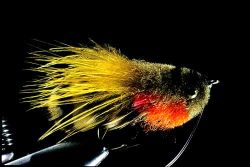 Shineabou Sunfish
Shineabou Sunfish
The Shineabou Sunfish, created by Jimmy Nix, has a double Matuka wing—one below, one on top of the body. It's trickier to make than the standard Matuka wing, but not all that much trickier.
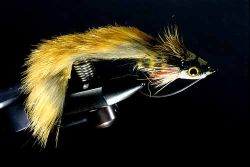 Whitlock's Hare Waterpup
Whitlock's Hare Waterpup
Dave Whitlock's Hare Waterpup has a fur-covered strip of rabbit-hide secured to the body with a rib of copper wire—sound anything like a Matuka wing?
Tying Strategies for Proven Results
The obvious tactic for improving almost any tying technique is simply to slow down, but it's particularly relevant with the Matuka wing.
In Production Fly Tying, A.K. Best says:
Tying Matuka-style wings is not fast.
Don't even try to hurry. Everything will go wrong if you do.
That certainly fits with my experience.
Important Tips and Tactics for Stripping the Wing Properly
One part of the process that will improve in particular with a little added care, and the attendant added time, is the trimming and stripping of the wing-hackles.This may not entirely make sense until you've read through the captions to come,
but, as you measure the cupped wing-feathers against the body, keep the following points in mind:
- Measure with care,
- separate the fibers for the stripping accurately,
- be sure to strip all of, but only, the fibers in front of the separation,
- take a little extra care (and time) to run the rib neatly through the open "V" in the fibers with each turn—do this roughly
and you'll have a splayed mess of a wing, and
- finally, make sure, as the following captions instruct, to bind the rib along the top of the hook's shank and begin binding the wing only after the rib has come around at the end of its first turn.
How to tie a Matuka Wing:
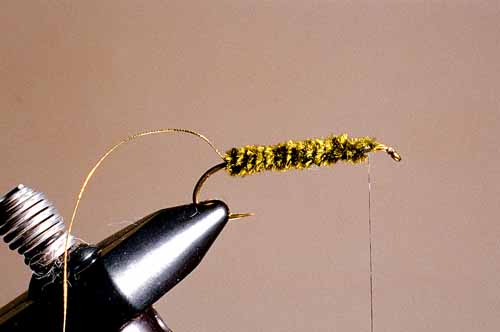 Step 1
Step 1
1. Bind the oval tinsel or copper wire along the top of the hook's shank, projecting off the hook's bend. Build the body (dubbing, chenille, whatever).
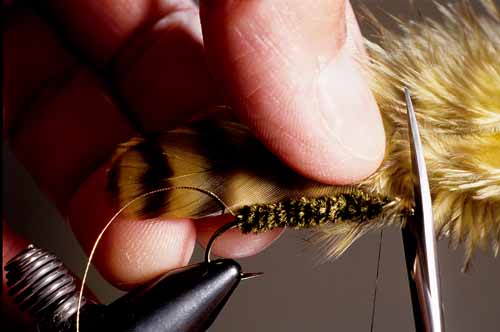 Step 2
Step 2
2. Select two matching hackles, and then cup them together, tips evened. (With more than two hackles, divide them into cupped sets—two and two, or three
and three.) Hold the hackles alongside the body.
The tips of the hackles should project beyond the rear of the body a distance of at least half the hook shank's
length to a full hook's length. Trim off the butts of the hackles just behind the hook's eye.
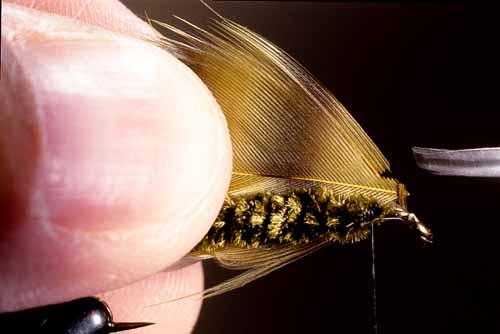 Step 3
Step 3
3. Trim back the tops of the hackles closely, just 1/16-inch or so.
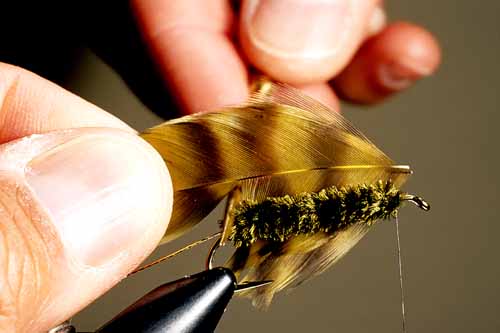 Step 4
Step 4
4. Push your bodkin into the fibers on the underside of the hackles at the rear of the body and part the fibers. Strip off all the fibers forward of the parting.
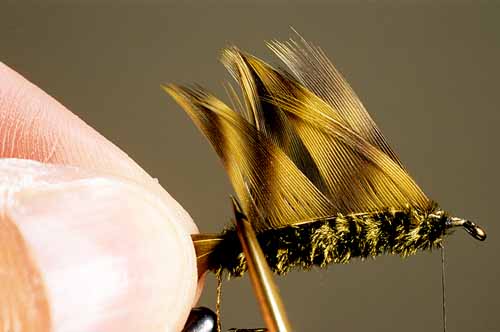 Step 5
Step 5
5. Bind the hackles by their trimmed butts at the front of the body. Hold the hackles down atop the body, grasping them by their tips. Push the point of your bodkin into the hackle fibers and part them a little forward of the rear of the body.
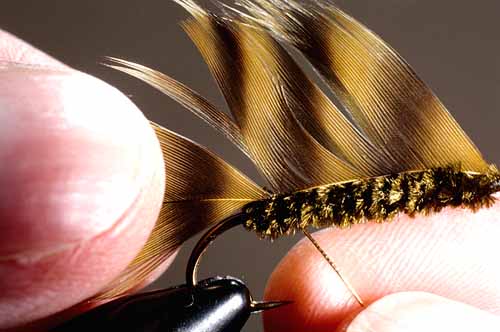 Step 6
Step 6
6. Wind the rib (which should be coming from the top of the hook) once around the body, forward in a spiral, and then through the parted fibers. Now the wing is secured—you can let go of the hackles' tips (so long as you keep tension on the rib).
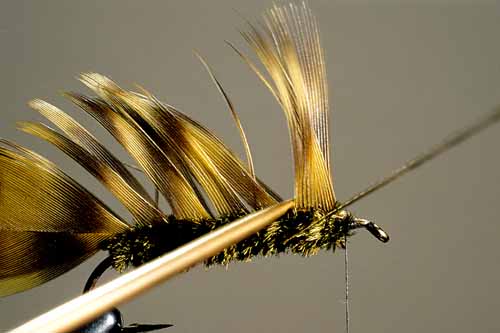 Step 7
Step 7
7. Continue parting the fibers with the bodkin and winding the rib through the parts until the rib reaches the front of the body. Bind the end of the rib and then trim it closely.
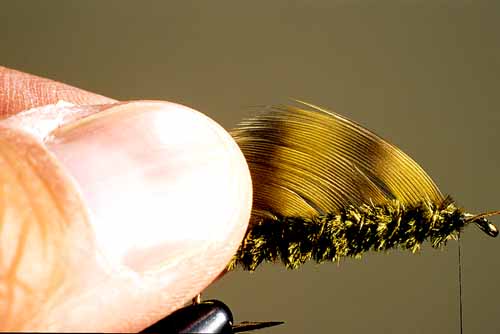 Step 8
Step 8
8. Stroke the fibers a few times until the parts close and the fibers are joined again as a flat section.
To finish out the standard Matuka, all that remains is to make a soft hackle-collar between the body and the eye.
Matuka-style Wings on Two Flies:
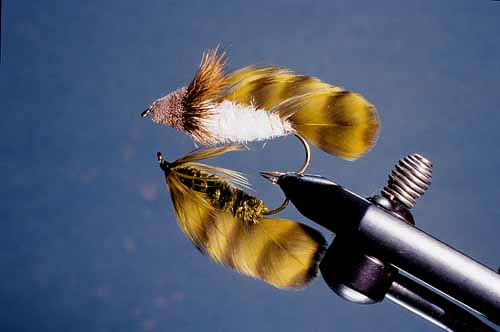 Two finished flies with Matuka-style wings—one a sculpin-style pattern(top),
Two finished flies with Matuka-style wings—one a sculpin-style pattern(top),
and the other the Olive Matuka(bottom).
Click here to hear Skip's interviews on popular podcasts...
*Announcements*
Skip has an essay in Big Sky Journal's annual Fly Fishing issue, called "Montana Hoppers: the Princess and the Brute" released February 1, 2023. Skip rewrote it a bit; I painted and illustrated it here, on our website. Here's the link on our web page to check it out:
Click here to read Skip's essay Montana Hoppers: The Princess and the Brute...
Skip's latest books:
Top 12 Dry Flies for Trout Streams: How, When, and Where to Fish Them, is now available on Amazon as an ebook...check it out! Click on the links below to go to the information page on Top 12 Dry Flies (the link to Amazon is at the bottom of the page...)
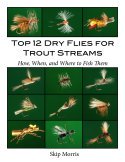 Top 12 Dry Flies for Trout Streams: How, When, and Where to Fish Them
Top 12 Dry Flies for Trout Streams: How, When, and Where to Fish Them
Click here to get more information about
Top 12 Dry Flies for Trout Streams: How, When, and Where to Fish Them (the link to Amazon is at the bottom of the page)...
Top 12 Dry Flies for Trout Streams: How, When, and Where to Fish Them (the link to Amazon is at the bottom of the page)...
Top 12 Nymphs for Trout Streams: How, When, and Where to Fish Them, 2nd Edition, originally published as an e-book only, is now available on Amazon as a paperback...check it out! Click on the links below to go to the information page on Top 12 Nymphs (the link to Amazon is at the bottom of the page...)
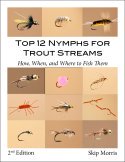 Top 12 Nymphs for Trout Streams: How, When, and Where to Fish Them (2nd Edition)
Top 12 Nymphs for Trout Streams: How, When, and Where to Fish Them (2nd Edition)
Click here to get more information about
Top 12 Nymphs for Trout Streams: How, When, and Where to Fish Them (2nd Edition). . .
Top 12 Nymphs for Trout Streams: How, When, and Where to Fish Them (2nd Edition). . .
Click here to get more information about Skip's e-book,
500 Trout Streams...
500 Trout Streams...
Skip's latest paperback book:
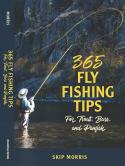 365 Fly Fishing Tips for Trout, Bass, and Panfish
365 Fly Fishing Tips for Trout, Bass, and Panfish
Click here to get more information about Skip's latest book,
365 Tips for Trout, Bass, and Panfish...
365 Tips for Trout, Bass, and Panfish...
Print Skip's chart for FREE:
Skip Morris's Trout-Fly Proportion Chart
Go to Skip Morris's Trout Fly Proportion Chart
Skip's Predator is available to buy...
Skip's ultra-popular Predator—a hit fly for bluegills and other panfishes and largemouth bass (also catches smallmouth bass and trout)—is being tied commercially by the Solitude Fly Company.
The Predator
CLICK HERE to learn more about or to purchase the Predator...
Learn to Tie Skip's Predator
Do you want to tie the Predator?
Tying the Predator
Skip shows you how to tie it on his YouTube Channel link, listed below:
CLICK HERE to see Skip's detailed video on how to tie the Predator...






